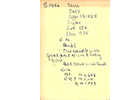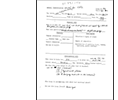|
L O C U S D A T A B A S E • S T R A T I G R A P H I C U N I T S
|
 |
For the Kelsey excavations of 1925, we can match certain numbered artifacts to specific workdays, but not necessarily to specific contexts. Nevertheless, Kelsey did produce a generally reliable stratigraphic sequence ( Tanit I-III) for his preliminary report, used by Harden for his ceramic typology ( Kelsey 1925, Harden 1937), with each phase divided by a sterile yellowish strata. Such divisions were not discernable during the ASOR Punic Project, although one such division has been found in recent INP excavations.
sample: locus 884, reg.S1446
©2023 KMA Carthage Excavation Records (box 4)
|
 |
For the Stager excavations of 1976-79, we have precise stratigraphic records, employing the methods used in the Levant and on Cyprus. In the early 1970s, Stager was on staff at ASOR excavations at Tell el-Hesi and was trained in their excavation methods (Blakely and Toombs 1980). These methods were refined at Idalion (Stager and Walker 1989, cf. Greene 1987) and transferred to Carthage, even using the same locus sheet template to record stratigraphic units (left).
Beside confirming the three phases discerned by Kelsey-Harden, the ASOR Punic Project further discerned eight sub-phases. The loci in the consistently excavated CT1 served as the key to correlating stratigraphic units across the site.
sample: locus sheet CT79.1.176.5882
©2023 HMANE ASOR Punic Project
CT_locus at OpenContext
|
|
exhibition goals: The exhibition at the Badè would include images of locus sheets and annotated photos. At the Adams Gallery, the exhibit could include the diaries and notes of Kelsey and Peterson, and the scrapbooks of O'Neil (from the KMA), as well as the field diary, notes and snapshots of Harden (supplemented frot the Ashmolean archives.
|
|
|
|